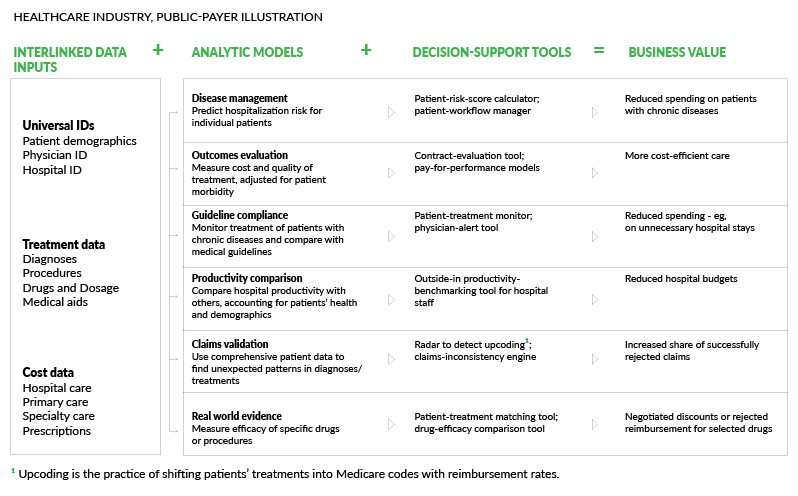Healthcare Analytics: How Big Data Can Save Lives
Technological advancements and medical breakthroughs go hand in hand. Laparoscopic surgeries, 3D-printed bionic limbs, implantable defibrillators are all great for fighting consequences. Healthcare data analytics, on the other hand, can help prevent health problems and diseases. Thanks to the immense volumes of information we can gather, data analytics and machine learning hold tremendous opportunities for the healthcare industry. Let’s look at the benefits Big Data can bring to save lives.
Fee-for-Value Vs. Fee-for-Service Medicine

The whole point of taking advantage of big data in the medical realm is shifting from traditional fee-for-service medicine to fee-for-value medicine. It implies that the new healthcare model should be based on the quality and not the number of services provided.
The value-based care model will encourage healthcare providers to monitor and take care of individuals, primarily with chronic illnesses since they’re more prone to be hospitalized. When doctors are motivated to keep their patients healthy, they’re more likely to take a closer look into the patient’s behavior and bad habits that may aggravate the already existing conditions.
Now, let’s take a look at the traditional fee-for-service model. Health providers are paid for office visits or for providing one-time treatments. This strips them of any motivation to check on the patients between treatments and make sure they’re actually getting better. Also, they don’t have access to any information about the patient’s previous treatment if another healthcare provider treated them. In fact, the providers aren’t incentivized to use data at all or improve their services.
All this shows how desperately we need a system that would combine all of this data to prevent people from visiting various doctors and getting non-personalised treatment.
7 Benefits of Big Data in the Healthcare Industry
Big Data can be a lifesaver for both patients and healthcare facilities. Just look at these seven examples.
Improving Management and Staffing Problems

Admission records can be used to predict the number of incoming patients at any given time. This will let hospitals avoid the problem of both understaffing and overstaffing. Using Big Data to make sense of admission records will let you know how many people are required to provide quality care, allow managers to monitor expenses better and make sure patients are getting proper treatments.
Electronic Health Records
Making digital records of every patient available to both public and private health sectors will let doctors keep track of that information and change it on an ongoing basis. Consequently, the patient’s medical history, lab tests, allergies – you name it – will be stored in a single secure system, accessible for authorized institutions.
Encouraging Patient Collaboration

Smart devices already let us keep track of our activities, sleeping habits and heart rate. While this information is entertaining for us, it’s actually valuable for healthcare providers who can suggest better treatment based on our daily habits. This also makes patients monitor their health and not come to the doctor when the consequences are already influencing their life quality.
Real-Time Alerts
Imagine a world where doctors are instantly alerted about the changes in their patients’ health conditions. Wearables might be the way to do that if they send the gathered health data to the cloud right away. With the help of Big Data, healthcare providers and national health organizations would then decipher the data and make better predictions concerning the future of the healthcare system in general.
Preventing Drug Abuse

There’s no way to tell how many times a person has gone to different doctors to get prescription drugs. This is one of the ways people can get away with drug abuse. But a single system that keeps records of all the visits would make going to various doctors to “treat” the same illness impossible.
Help with Curing Diseases
Finding a cure for cancer is an ongoing battle that Big Data can help us win. If researches had access to all the medical records of patients with cancer, they would be able to monitor how specific treatments affect the disease. Taking all that into account could help discover new treatments.
Predictive Analytics

Predictive analytics has been one of the biggest business intelligence trends for the last couple of years. Once doctors learn to take advantage of it, they will make data-driven decisions instead of subjective ones.

Challenges of Healthcare Analytics
We’ve got data, a lot of data, and we’re lucky to own so much valuable healthcare information. That said, we also have to be realistic about the challenges these volumes of data bring.
Lack of Necessary Skills
Did you know that each year the volume of healthcare data is growing by 48%? Not using algorithms that would be able to sort it out and give reliable results would be a crime against humanity. Here’s where we meet our first challenge – there are currently not enough specialists who have the necessary skills to make use of all that data.

Working with data doesn’t only require technical skills; it also requires a plan. McKinsey suggests three core elements of a successful healthcare data plan: data, analytic models and tools. Once you combine the three of them and employ a professional data engineer, you’re sure to get the most of your data.
Shift to Data-Driven Organizations

Making data-driven decisions requires training your employees to make use of it. As easy as it sounds, changing the way people work and behave is one of the hardest tasks. Yes, the whole mindset of your organization would have to shift to an entirely new level, but the results will make everything worth it.
Privacy Concerns
This is probably one of the most complicated challenges healthcare analytics is facing today. When it comes to sharing patient’s data, confidentiality issues are hard to fight. Not all people want to share their entire medical history and let others “judge” it. Also, healthcare providers tend to keep their researches and patient’s data secure to prevent threats. If it sounds hard to apply this system to one country, imagine how challenging it would be to build a global one.
The Future in Action
Luckily, none of these challenges are unsolvable. The tech industry is always there to help healthcare bring more value to patients and save lives. Take a look at these MedTech advancements presented at the HIMSS19:
- VivaLNK introduced IoT medical wearables that come with the “Internet of Health Things” data cloud.
- TriFin Labs showed their Enlyt Health patient engagement platform. It combines Salesforce and other features to lower health system costs.
- eMDs revealed Aria Health Services designed to help healthcare providers focus on patient care and its outcomes rather than administrative issues.
Royal Phillips unveiled IntelliSpace Epidemiology. It’s a system that helps optimize and detect infections that can be spread in the hospital.
Bottom Line
Data is the most valuable tool healthcare providers can use to improve their patients’ medical conditions. Using healthcare analytics and Big Data algorithms can help predict and cure illnesses, maintain electronic health records and manage hospital staffing better. And though there are still issues that need to be solved, like lack of necessary skills or privacy concerns, Big Data has all the potential to transform healthcare as we know it. We just need to combine our efforts and work together toward a unified healthcare monitoring system.

